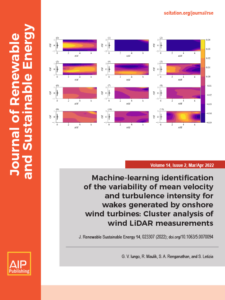
A team of researchers including University of Utah mechanical engineering assistant professor Ashwin Renganathan and collaborators from the Argonne National laboratory and the University of Texas at Dallas have been studying how to apply machine learning toward the design of wind turbine farms. Their recent article was featured on the cover of the Journal of Renewable and Sustainable Energy as well as being featured as a Sclight article across AIP publications.
In wind farms where you have a lot of turbines together, performance and maintenance issues can arise from how the wind interacts between turbines. Individual turbines create wakes with lower wind velocity and higher turbulence, which can impact downstream turbines. In the past, numerical simulations looking at these wakes have been limited due to simplification of complex behaviors, leading to less accurate results.
In this work, the team applied techniques from machine learning and data science to analyze large scale measurements from LiDAR looking upstream and downstream from wind turbines at an onshore wind farm; the data represented various atmospheric conditions and other uncontrollable turbine parameters. They then used clustering techniques to identify the most representative realizations of wind turbine wakes. This approach allowed for efficient data reduction and flow statistic extraction that would not have been possible through more classical analysis methods.
“The main challenge was the enormity of the data,” said Renganathan. “Furthermore, the data was corrupted by measurement noise, unknown structural uncertainties, and sometimes incompleteness. Therefore, the uniqueness of this work is the demonstration of how emerging techniques in machine learning can be used to analyze large scale, imperfect, real-world data to extract useful insights that can then be used to improve the performance and design of complex engineered systems (in this case wind farms).”
These results can inform big picture models, as well as helping correct individual turbines. Renganathan and the rest of the team are looking at expanding the approach to monitor a large number of turbines in Oklahoma for the AWAKEN experiment, as well as beginning to investigate offshore turbines.